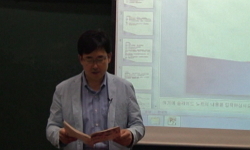The Philippines was colonized by Spain for about centuries, from 1521 to 1898, and ruled by America for around four decades, from 1899 to 1946. After recovering from the Second World War, the government started to harness human labor as export itself....
http://chineseinput.net/에서 pinyin(병음)방식으로 중국어를 변환할 수 있습니다.
변환된 중국어를 복사하여 사용하시면 됩니다.
- 中文 을 입력하시려면 zhongwen을 입력하시고 space를누르시면됩니다.
- 北京 을 입력하시려면 beijing을 입력하시고 space를 누르시면 됩니다.
https://www.riss.kr/link?id=A103604004
-
저자
파트릭 플로레 (필리핀대학교) ; Flores, Patrick D.
- 발행기관
- 학술지명
- 권호사항
-
발행연도
2009
-
작성언어
English
- 주제어
-
등재정보
KCI등재후보
-
자료형태
학술저널
-
수록면
89-123(35쪽)
-
KCI 피인용횟수
0
- 제공처
- 소장기관
-
0
상세조회 -
0
다운로드
부가정보
다국어 초록 (Multilingual Abstract)
The Philippines was colonized by Spain for about centuries, from 1521 to 1898, and ruled by America for around four decades, from 1899 to 1946. After recovering from the Second World War, the government started to harness human labor as export itself. In the present time the overseas Filipinos keep the economy afloat with their steady transfer of money to relatives and dependents. Through the art works, the issue which Filipinos were exploited and exported by its government has been reflected as the various allegories. As Filipinos traditionally follow and keep Catholic belief, themes of Christ's sacrifice has allegorically been represented as salvation, struggle, suppression, and emancipation of people. Through the allegory, we can interpret both the intrinsic and superficial texts. Also we can identity certain modes of the visuality of allegory in selected works from Philippine art history that in their complex mediations materialize the people and dignity of their predicament and their prevailing. Philippine art can be divided as three different features: passion, vagrancy, and mass formation. The passion stage was depicted as deep structure of Christian thought and devotional feeling, harsh capitalist system. In the pictures of vagrancy, under the regime of Ferdinand Marcos, the themes of drift, deprivation, and homelessness are reckoned through the images of pictures. The stories represented with allegory have been played an important role to bring local issues up as national ones. Those stages take us to the processes of mass formation or the depiction of the people as a moment in the totality of force. The allegorical sign refers to another sign that precedes it, but with which it will never able to coincide reach back to a previous stage and in this constant attempt at return incorporates a structural distance from its origin. The true people's art is one that radically generates transformative technologies and techniques so that it irrevocably breaks the plane of "art". In the painting, the truth is represented by functioning as foundation of a rhetoric of the image. And at this axis, the passional, the vagrant, and the mass formation tend to come together because they render the form of contingency that must be suffered and hopefully surpassed, a Filipino subjectivity that must be stitched in time.
참고문헌 (Reference)
1 Rafael, Vicente, "White Love and Other Events in Filipino History" Ateneo de Manila University 2000
2 Merback, Mitchell, "The Thief, The Cross and the Wheel: Pain and the Spectacle of Punishment in Medieval and Renaissance Europe" Chicago University Press 1998
3 Grootenboer, Hanneke, "The Rhetoric of Perspective: Realism and Illusionism in Seventeenth-Century Dutch Still-Life Painting" University of Chicago Press 2005
4 Benjamin, Walter, "The Origin of German Tragic Drama" Verso 1998
5 Hosillos, Lucila, "Originality as Vengeance in Philippine Literature" New Day Publishers 1984
6 Bryson, Norman, "Looking at the Overlooked: Four Essays on Still Life Painting" Cambridge University Press 1990
7 Melendrez-Cruz, Patricia, "Himalay: Kalipunan ng mga Pag-aaral Kay Balagtas" Cultural Center of the Philippines 1988
8 Agoncillo, Teodoro, "Graciano Lopez Jaena: Speeches, Articles and Letters. Manila: National Historical Commission, 1974. Quoted in Zero In: Private Art. Public Lives, Manila: Eugenio Lopez Foundation, Inc., Ayala Museum, Ateneo Art Gallery"
9 "Filipinas Puerta de Oriente: De Legazpi a Malaspina, Comisaria para la Celebracion del V Centenario del Nacimiento de Don Miguel Lopez de Legazpi"
10 "C. S. Lewis quoted in Nuttall, A. D. Two Concepts of Allegory: A Study of Shakespeare’s The Tempest and the Logic of Allegorical Expression" Routledge and Kegan Paul 1967
1 Rafael, Vicente, "White Love and Other Events in Filipino History" Ateneo de Manila University 2000
2 Merback, Mitchell, "The Thief, The Cross and the Wheel: Pain and the Spectacle of Punishment in Medieval and Renaissance Europe" Chicago University Press 1998
3 Grootenboer, Hanneke, "The Rhetoric of Perspective: Realism and Illusionism in Seventeenth-Century Dutch Still-Life Painting" University of Chicago Press 2005
4 Benjamin, Walter, "The Origin of German Tragic Drama" Verso 1998
5 Hosillos, Lucila, "Originality as Vengeance in Philippine Literature" New Day Publishers 1984
6 Bryson, Norman, "Looking at the Overlooked: Four Essays on Still Life Painting" Cambridge University Press 1990
7 Melendrez-Cruz, Patricia, "Himalay: Kalipunan ng mga Pag-aaral Kay Balagtas" Cultural Center of the Philippines 1988
8 Agoncillo, Teodoro, "Graciano Lopez Jaena: Speeches, Articles and Letters. Manila: National Historical Commission, 1974. Quoted in Zero In: Private Art. Public Lives, Manila: Eugenio Lopez Foundation, Inc., Ayala Museum, Ateneo Art Gallery"
9 "Filipinas Puerta de Oriente: De Legazpi a Malaspina, Comisaria para la Celebracion del V Centenario del Nacimiento de Don Miguel Lopez de Legazpi"
10 "C. S. Lewis quoted in Nuttall, A. D. Two Concepts of Allegory: A Study of Shakespeare’s The Tempest and the Logic of Allegorical Expression" Routledge and Kegan Paul 1967
11 Yuson, Alfred, "Bencab" Mantes Publishing 2002
12 San Juan, Jr. E., "Balagtas: Art and Revolution" Manlapaz Publishing 1969
13 Eugenio, Damiana, "Awit and Corrido: Philippine Metrical Romances" University of the Philippines Press 1987
14 Fletcher, Angus, "Allegory: The Theory of a Symbolic Mode" Cornell University Press 1964
15 Whitman, Jon, "Allegory: The Dynamics of an Ancient and Medieval Technique" Harvard University Press 1987
동일학술지(권/호) 다른 논문
-
- 한국미술이론학회
- 邹跃进
- 2009
- KCI등재후보
-
Figuring the Social Condition: The Role of Allegory
- 한국미술이론학회
- Patrick D. Flores
- 2009
- KCI등재후보
-
- 한국미술이론학회
- 파트릭 플로레
- 2009
- KCI등재후보
-
소련 사회주의 리얼리즘에 관하여: '국민과 예술'의 문제
- 한국미술이론학회
- 알렉산드르 모르조프
- 2009
- KCI등재후보
분석정보
인용정보 인용지수 설명보기
학술지 이력
| 연월일 | 이력구분 | 이력상세 | 등재구분 |
|---|---|---|---|
| 2027 | 평가예정 | 재인증평가 신청대상 (재인증) | |
| 2021-01-01 | 평가 | 등재학술지 유지 (재인증) |  |
| 2018-01-01 | 평가 | 등재학술지 유지 (등재유지) |  |
| 2015-01-01 | 평가 | 등재학술지 유지 (등재유지) |  |
| 2011-01-01 | 평가 | 등재학술지 선정 (등재후보2차) |  |
| 2010-01-01 | 평가 | 등재후보 1차 PASS (등재후보1차) |  |
| 2009-01-01 | 평가 | 등재후보 1차 FAIL (등재후보1차) |  |
| 2008-03-27 | 학회명변경 | 영문명 : The Korean Association of Art Theories -> The Korean Society of Art Theories |  |
| 2007-01-01 | 평가 | 등재후보학술지 선정 (신규평가) |  |
학술지 인용정보
| 기준연도 | WOS-KCI 통합IF(2년) | KCIF(2년) | KCIF(3년) |
|---|---|---|---|
| 2016 | 0.19 | 0.19 | 0.38 |
| KCIF(4년) | KCIF(5년) | 중심성지수(3년) | 즉시성지수 |
| 0.37 | 0.32 | 0.896 | 0.07 |





 ScienceON
ScienceON







